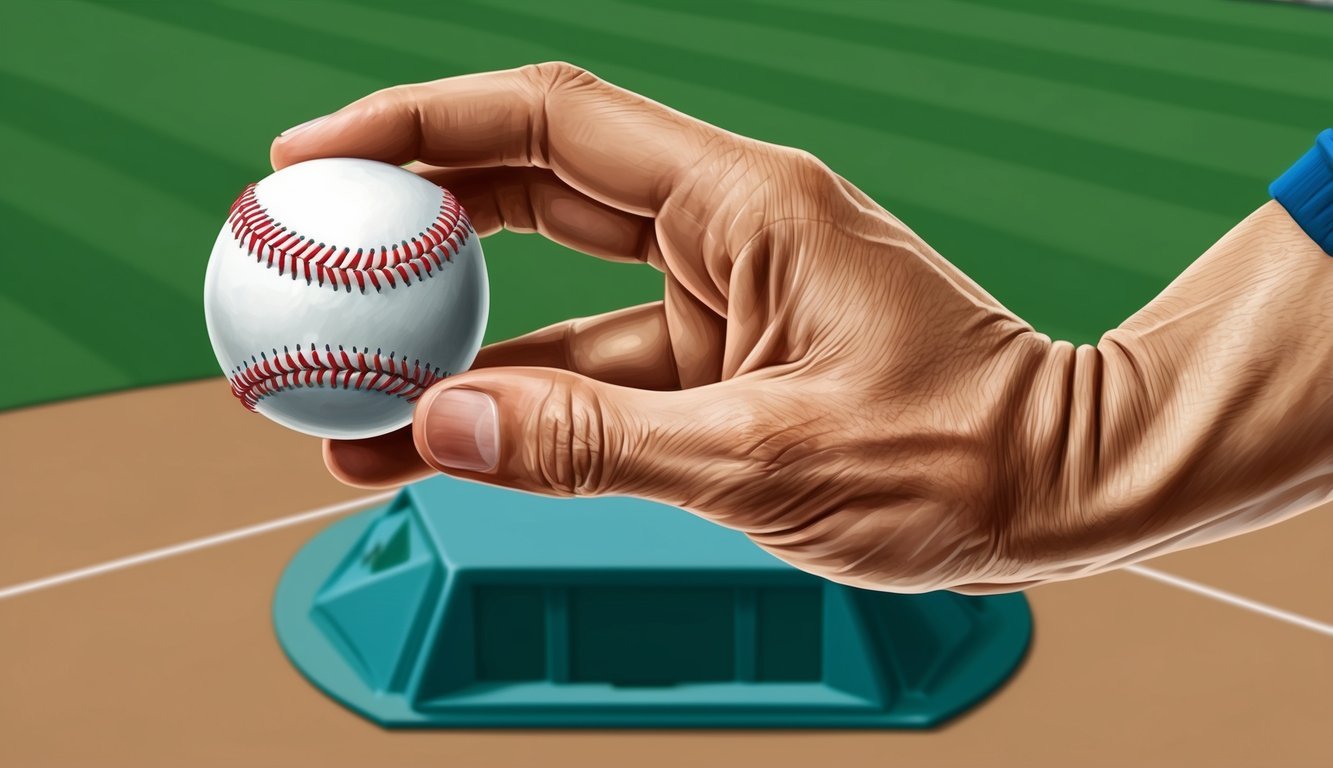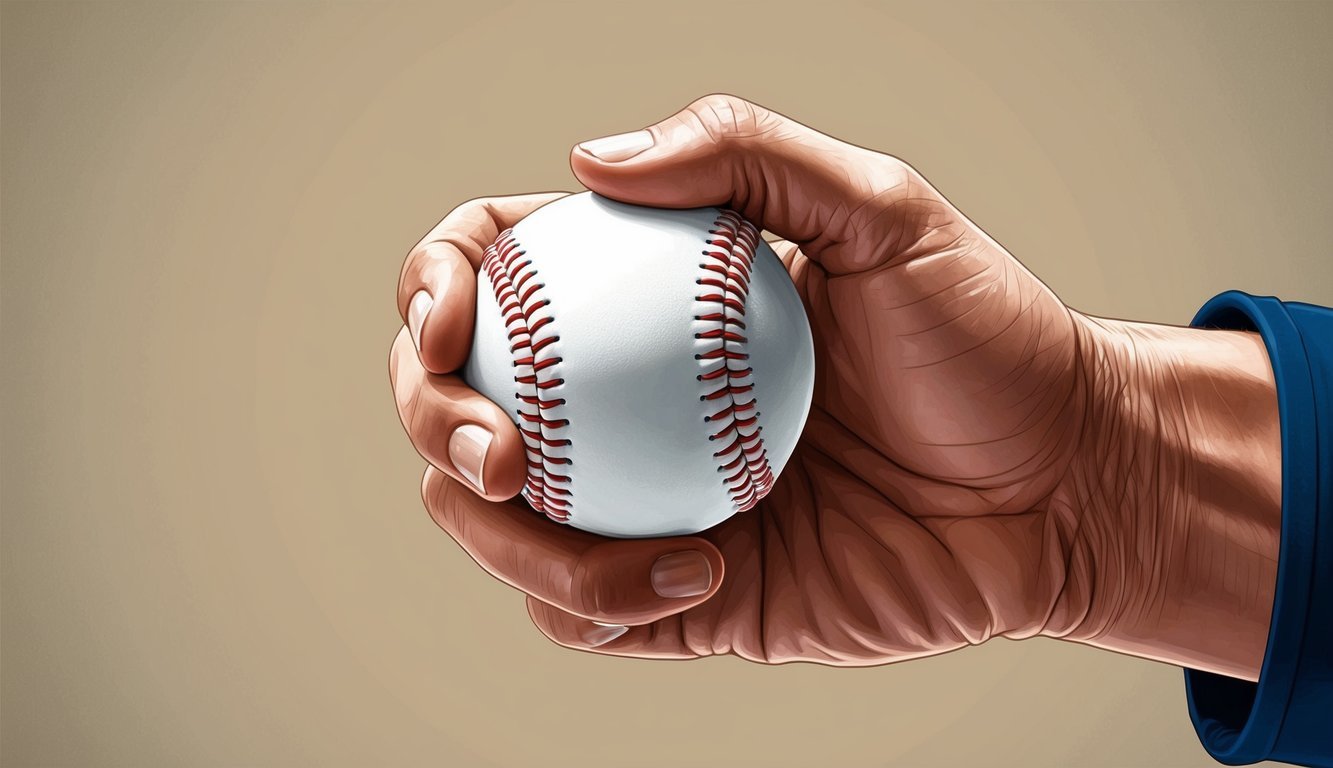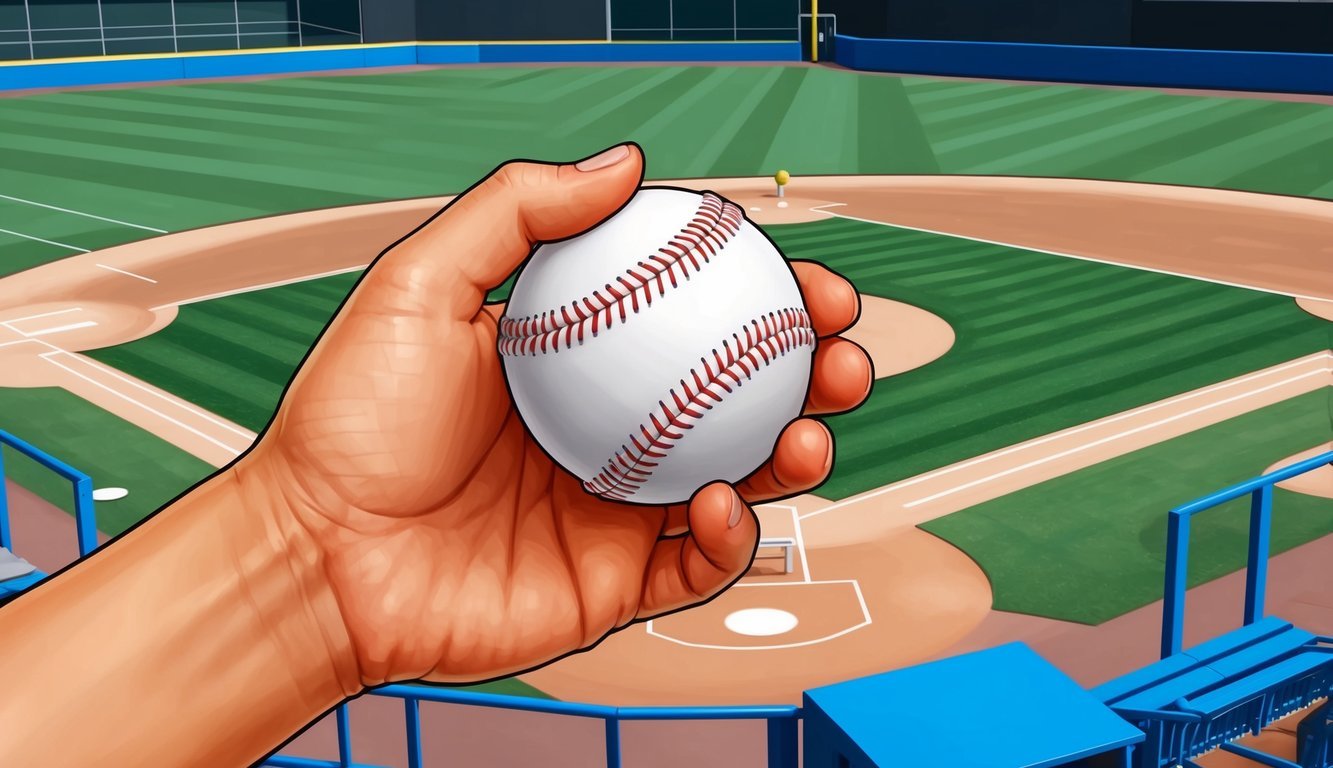The two-seam fastball is a versatile pitch that can baffle batters with its subtle movement.
This grip variation on the standard fastball creates tailing action and sink, making it challenging for hitters to square up. Pitchers place their index and middle fingers along the two closest seams where they come together on the horseshoe to throw a two-seam fastball.
Mastering the two-seam grip allows pitchers to induce more ground balls and weak contact.
The pitch typically moves arm-side with late downward break, giving it the alternate names “sinker” or “tailing fastball.” While slightly slower than a four-seam fastball, the two-seamer’s movement often makes up for the velocity difference.
Many successful Major League pitchers like Joe Kelly and Logan Webb rely on the two-seam fastball as an effective weapon in their arsenals.
Learning proper finger pressure and release techniques can help pitchers at all levels add this valuable pitch to their repertoire.
With practice, the two-seamer can become a go-to offering for getting crucial outs.
Fundamentals of the 2 Seam Fastball Grip
The 2 seam fastball grip is a crucial technique for pitchers looking to add movement and deception to their repertoire.
Mastering this grip involves understanding the baseball’s seams, precise finger placement, and proper thumb positioning.
Understanding the Seams
The 2 seam fastball gets its name from the two seams that run alongside the ball.
These seams are closer together than those used for a 4 seam fastball.
Pitchers align their fingers with these seams to create the desired movement.
The seams play a vital role in the ball’s trajectory.
As the ball spins, the air interacts with the seams, causing the pitch to move laterally.
This movement is typically arm-side, meaning it breaks towards the throwing arm of a right-handed pitcher.
Pitchers should familiarize themselves with the feel of these seams.
Practicing with the ball helps develop muscle memory for quick and consistent grip placement.
Finger Placement and Pressure Points
Proper finger placement is key to executing an effective 2 seam fastball.
The index and middle fingers should be placed directly on top of the seams where they’re closest together.
Pitchers apply pressure mainly with their fingertips.
This pressure influences the ball’s spin and, consequently, its movement.
Slight adjustments in finger pressure can significantly alter the pitch’s behavior.
Some pitchers prefer to spread their fingers slightly, while others keep them close together.
Experimenting with different finger spacings can help find the most comfortable and effective grip.
It’s important to maintain a relaxed grip.
Squeezing the ball too tightly can reduce movement and velocity.
Thumb and Index Finger Position
The thumb plays a crucial role in the 2 seam fastball grip.
It should be placed directly opposite the index and middle fingers, on the leather between the seams.
This thumb placement helps create the desired spin and provides stability during the release.
Some pitchers prefer to place their thumb slightly off-center to enhance movement.
The index finger’s position is particularly important.
It should be aligned with one of the seams, with the fingertip making firm contact.
This finger often bears slightly more pressure than the middle finger.
Pitchers may experiment with subtle variations in thumb and index finger placement to find what works best for their throwing style and desired pitch movement.
Pitching Mechanics and Delivery

Mastering the 2-seam fastball grip requires attention to key mechanical elements.
Proper arm slot, wrist action, and release techniques work together to create the pitch’s signature movement.
Arm Slot and Wrist Action
Pitchers typically use a three-quarter arm slot for the 2-seam fastball.
This angle allows for natural arm-side run and sink.
The wrist should remain firm and straight upon release.
To maximize movement, some pitchers slightly pronate their wrist at release.
This action imparts additional spin and can enhance the pitch’s effectiveness.
Experimenting with arm slots can help pitchers find their optimal release point.
A lower arm slot may increase movement but could sacrifice velocity.
Release Techniques for Optimal Spin
Proper finger pressure is crucial for generating spin.
Pitchers should apply equal pressure with their index and middle fingers along the seams.
At release, focus on pulling down on the outside of the ball.
This motion creates the desired spin and movement.
Timing is key.
Release the ball slightly later than a 4-seam fastball to achieve more downward action.
Practice with a slow-motion camera can help refine release techniques and improve consistency.
Common Mistakes and Corrections
Overthrowing is a frequent issue.
It can lead to reduced movement and control, so focus on smooth mechanics rather than maximum effort.
Some pitchers grip the ball too tightly, limiting spin and movement.
A relaxed grip allows for better feel and release.
Inconsistent arm speed can tip off batters, so make sure to maintain the same arm speed as other pitches to keep hitters guessing.
Opening the front side too early reduces power and control, so work on staying closed and driving toward home plate.
Regular bullpen sessions with a coach or catcher can help identify and correct these common mistakes.
Practicing the 2 Seam Fastball
Mastering the 2 seam fastball requires dedicated practice and specific drills.
Pitchers can improve their control, accuracy, and velocity through targeted exercises and real-game applications.
Drills for Better Control and Accuracy
Finger pressure drills help pitchers maintain consistent grip on the ball.
Place the index and middle fingers along the seams and practice applying even pressure.
This improves feel and release consistency.
Wall throws are excellent for refining accuracy.
Stand about 10 feet from a wall and aim for a small target.
Focus on hitting the same spot repeatedly with the 2 seamer.
The towel drill enhances arm motion and release point.
Snap a small towel through the pitching motion, emphasizing proper follow-through.
This builds muscle memory for a smooth delivery.
Bullpen sessions are crucial.
Set up targets in various parts of the strike zone and practice hitting them.
Start with 50% effort and gradually increase intensity as control improves.
Long Toss for Increasing Strength and Speed
Long toss builds arm strength and improves velocity.
Start at 60 feet and gradually increase distance.
Focus on maintaining proper mechanics throughout.
Use a crow hop to generate more power from the legs.
This translates to increased arm speed and ball velocity.
Incorporate weighted balls into long toss sessions.
Slightly heavier balls strengthen the arm, while slightly lighter ones improve arm speed.
Aim for a mix of high arcing throws and line drives.
This develops different arm angles and strengthens various muscle groups.
Incorporating the Pitch in Game Situations
Start by using the 2 seamer in low-pressure situations.
Throw it when ahead in the count or against weaker hitters.
Mix the 2 seamer with other pitches to keep batters off balance.
Pair it with a 4 seam fastball or changeup for contrast.
Use the pitch to induce ground balls.
Aim for the lower part of the strike zone to maximize its sinking action.
Practice throwing the 2 seamer to both sides of the plate.
This versatility makes it a valuable weapon against both right and left-handed batters.
Comparing Fastball Varieties

Fastballs come in several varieties, each with unique characteristics that affect their movement and effectiveness.
Pitchers use different grips and release techniques to create variations in speed and trajectory.
Two Seam Fastball vs. Four Seam Fastball
The two seam fastball and four seam fastball are the most common fastball types.
A two seam fastball is gripped along the two closest seams, creating more movement but slightly less speed.
It typically moves left to right or right to left, diving as it approaches the plate.
Four seam fastballs, gripped across the seams, are usually faster and straighter.
They maintain a more consistent trajectory due to the ball’s rotation.
This pitch is often 5-7 mph faster than a two seamer from the same pitcher.
Pitchers choose between these based on their strengths and the batter’s weaknesses.
A four seamer might overpower hitters, while a two seamer can induce ground balls.
Sinker and Running Fastball Explained
Sinkers and running fastballs are variations of the two seam fastball.
A sinker, as the name suggests, has a pronounced downward movement.
It’s thrown with a similar grip to a two seamer but with slight adjustments to create more sink.
Running fastballs move laterally more than they sink.
Right-handed pitchers throw running fastballs that move arm-side (towards a right-handed batter), while lefties’ running fastballs move towards left-handed batters.
Both pitches rely on friction and seam orientation to create movement.
They’re typically thrown a bit slower than four seamers but can be highly effective at generating weak contact and ground balls.
This movement is influenced by a pitcher’s grip, arm angle, and release point, which all contribute to the ball’s overall trajectory.
Understanding screwball pitch mechanics can further illustrate how spin and pressure differences affect a pitch’s break, often deceiving hitters.
Mastering these mechanics allows pitchers to manipulate movement and control, making their pitches even more deceptive and difficult to hit.
Adjusting for Different Levels of Play

The 2-seam fastball grip evolves as players progress through different levels of baseball.
Mastering this pitch requires adapting techniques and strategies to suit each stage of development.
Tips for Youth Baseball Players
Young pitchers should focus on proper finger placement when learning the 2-seam fastball grip.
Place the index and middle fingers just outside the seams, with the thumb underneath for balance.
Practice this grip regularly to build muscle memory.
Start with a relaxed grip to avoid squeezing the ball too tightly.
This helps maintain arm speed and prevents strain on developing arms.
Youth coaches often emphasize throwing strikes rather than maximum velocity at this stage.
Experiment with different finger pressures to find what feels comfortable and produces the desired movement.
Remember, consistency is key for young players developing this pitch.
Strategies for Collegiate Level Competition
College pitchers can refine their 2-seam fastball grip to increase effectiveness.
Focus on subtle adjustments to finger pressure and release point to enhance movement.
Many collegiate hurlers find success by slightly offsetting their fingers on the seams.
Develop a consistent arm slot for the 2-seamer to disguise it from other pitches.
This deception is crucial against advanced hitters.
Work on maintaining arm speed to match your 4-seam fastball, preventing tipping off batters.
Utilize pitch sequencing to set up the 2-seamer effectively.
Mixing in off-speed pitches can make the 2-seam fastball even more potent as a put-away pitch or for inducing weak contact.
Professional Insights from Famous Pitchers
MLB stars like Justin Verlander and Max Scherzer have shared valuable insights on their 2-seam fastball grips.
Verlander emphasizes that a loose grip is important to maximize arm-side run.
Meanwhile, Scherzer focuses on finger pressure to control the pitch’s movement.
Greg Maddux, known for his command, used the 2-seamer as a primary weapon.
He stressed the importance of locating the pitch down in the zone to induce ground balls.
Corey Kluber’s success with the 2-seamer comes from his ability to throw it with varying velocities.
Gerrit Cole’s approach involves using the 2-seamer to complement his high-velocity 4-seam fastball, creating a devastating combination for hitters to handle.
